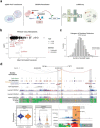This is a preprint.
MethNet: a robust approach to identify regulatory hubs and their distal targets in cancer
- PMID: 37577603
- PMCID: PMC10418566
- DOI: 10.21203/rs.3.rs-3150386/v1
MethNet: a robust approach to identify regulatory hubs and their distal targets in cancer
Update in
-
MethNet: a robust approach to identify regulatory hubs and their distal targets from cancer data.Nat Commun. 2024 Jul 17;15(1):6027. doi: 10.1038/s41467-024-50380-3. Nat Commun. 2024. PMID: 39025865 Free PMC article.
Abstract
Aberrations in the capacity of DNA/chromatin modifiers and transcription factors to bind non-coding regions can lead to changes in gene regulation and impact disease phenotypes. However, identifying distal regulatory elements and connecting them with their target genes remains challenging. Here, we present MethNet, a pipeline that integrates large-scale DNA methylation and gene expression data across multiple cancers, to uncover novel cis regulatory elements (CREs) in a 1Mb region around every promoter in the genome. MethNet identifies clusters of highly ranked CREs, referred to as 'hubs', which contribute to the regulation of multiple genes and significantly affect patient survival. Promoter-capture Hi-C confirmed that highly ranked associations involve physical interactions between CREs and their gene targets, and CRISPRi based scRNA Perturb-seq validated the functional impact of CREs. Thus, MethNet-identified CREs represent a valuable resource for unraveling complex mechanisms underlying gene expression, and for prioritizing the verification of predicted non-coding disease hotspots.
Conflict of interest statement
Additional Declarations: There is NO Competing Interest.
Figures







References
Publication types
Grants and funding
LinkOut - more resources
Full Text Sources
Molecular Biology Databases

